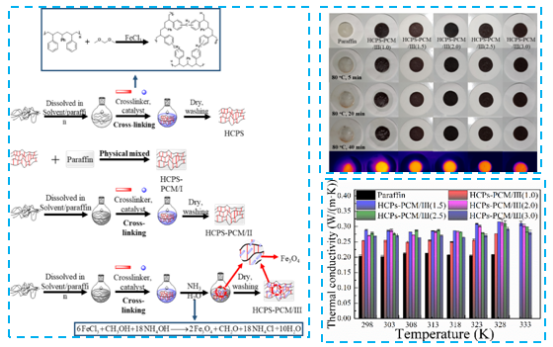Professor Rao Zhonghao’s Team Published New Research Achievements about Energy Storage in Journal of Materials of Chemistry A
Publisher : Time : 28.April 2019 Browse the number :

Recently, Prof. Rao Zhonghao’s team from the Electric Power College of China University of Mining and Technology, the first and only communication unit, has published a paper titled “A novel shape-stabilization strategy for phase change thermal energy storage” (DOI: 10.1039/c9ta01496a) in Journal of Materials of Chemistry A.
Energy storage technology is an essential means to solve the mismatch of energy supply in time and space and mitigated the energy crisis. Phase change energy storage has the advantages of low cost and wide application range. From the morphology of phase change, it can be divided into solid-liquid phase change, solid-solid phase change and liquid-gas phase change. And solid-liquid phase change is widely used as energy storage medium because of its high latent heat and small volume change during phase change. However, solid-liquid phase change materials have some shortcomings, such as low thermal conductivity and leakage after phase change, so the solution of these problems can effectively promote the wide application of phase change materials in energy storage field.
Prof. Rao Zhonghao's team used polystyrene as raw material, FeCl3 as catalyst, 1,1-dimethoxymethane as crosslinking agent, and Friedel-Crafts reaction to coat phase change material paraffin in situ. Experiment results show that the maximum coating efficiency of phase change materials can reach 90.6%. The mechanism study indicates that the formation of hyper- crosslinking polymer and the coating of phase change materials are carried out at the same time, which ensures the efficient coating of phase change materials. At the same time, the catalytic reaction catalyst FeCl3 was transformed into Fe3O4 nano-rods with a size of 30 nm * 150 nm through a simple ammonia water treatment after the material was finalized, thus enhancing the thermal conductivity of the material. The experimental results show that the thermal conductivity of the composites is 55% higher than that of pure paraffin. Prof. Rao Chung Ho's team further studied the application of the waste polystyrene foam in the technology. Through the optimization of the conditions, the notorious "white trash" is also applied to the energy storage process, and shows the energy storage performance comparable with the commercial polystyrene.
The first author of this paper Dr. Liu Changhui, a post-doctor of Tokyo University in Japan, joined the team in May, 2018. He is engaged in the cross-study of chemistry, materials and energy storage technology. Other participants are Zhao Jiateng, Liu Chenjun, HuoYutao and other young teachers in the team. Pr. Rao Zhonghao is corresponding author of this paper.
Source: Liu Changhui from College of Electrical and Power Engineering
Editor: Li Xiu
Reviewer: Liu Zunxu